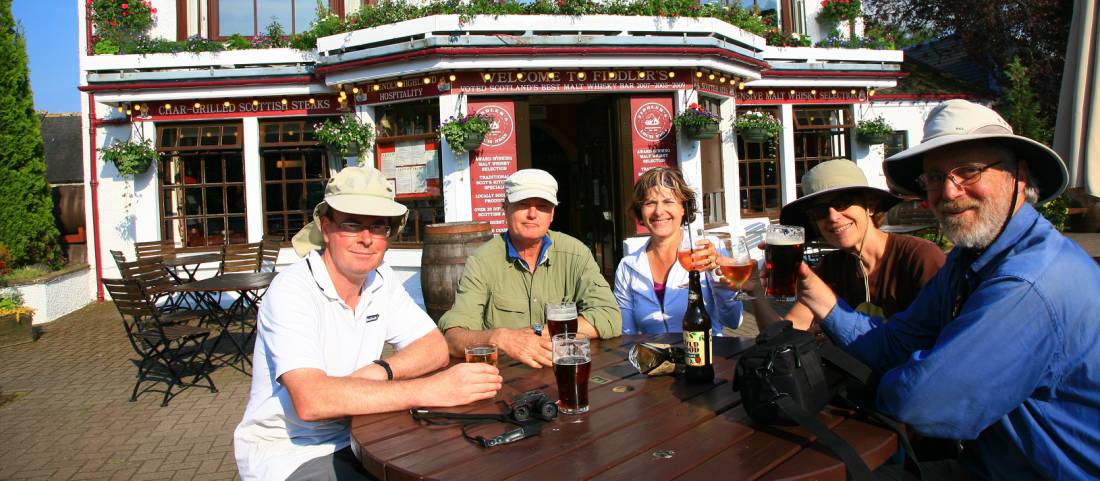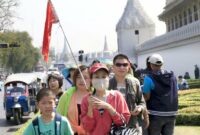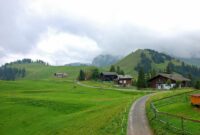Walking Tours Europe Seniors: Discover the charm of Europe at your own pace. This guide caters specifically to the needs and preferences of senior travelers, offering insights into planning unforgettable walking tours across Europe’s most captivating cities. We’ll explore suitable destinations, consider accessibility, and delve into creating enriching and comfortable experiences tailored to the unique requirements of senior adventurers.
From identifying ideal cities with excellent accessibility features to designing itineraries that incorporate rest stops and manageable walking distances, we aim to empower seniors to explore the beauty and history of Europe with confidence and enjoyment. We’ll also cover essential logistical considerations, marketing strategies, and practical tips to ensure a smooth and memorable travel experience.
Understanding the Target Audience
Senior travelers represent a significant and growing segment of the tourism market, with distinct needs and preferences that must be considered when designing walking tours. This demographic often values enriching cultural experiences, comfortable pacing, and convenient logistics, all while prioritizing safety and accessibility. Understanding these factors is crucial for creating successful and enjoyable walking tours specifically tailored to seniors.
Characteristics of Senior Travelers Interested in Walking Tours
Senior travelers interested in walking tours are typically active individuals who enjoy exploring new places and immersing themselves in different cultures. They often possess a strong interest in history, art, architecture, and local customs. Many are well-traveled and appreciate well-organized itineraries that balance exploration with relaxation. They may be traveling solo, as couples, or in small groups, often with friends or family. This shared experience is a significant motivator for their travel choices.
Specific Needs and Preferences of Senior Travelers
Senior travelers often prioritize comfort and convenience. This includes factors such as well-maintained walking surfaces, readily available restrooms, and opportunities for rest stops throughout the tour. Accessibility is paramount, with consideration for those using mobility aids such as walkers or wheelchairs. Clear communication is also vital, with itineraries and instructions provided in a clear and easily understandable format. Tours should avoid overly strenuous activities or long periods of standing. Many seniors appreciate smaller group sizes for a more personalized experience and easier interaction with the guide. They often value opportunities to engage with locals and learn about their culture firsthand.
Accommodating Physical Limitations
Physical limitations vary greatly among seniors. Some may have limited mobility, while others may experience issues with stamina or balance. Tour operators should offer options to accommodate these differences. This might involve providing alternative routes with fewer inclines or steps, allowing for more frequent rest breaks, offering transportation options for certain legs of the journey, and clearly communicating the physical demands of each tour in advance. Consider providing comfortable seating during breaks and allowing for a slower pace to accommodate individual needs. The use of assistive devices should be encouraged and facilitated.
Preferred Pace and Duration of Walking Tours for Seniors
Senior travelers generally prefer a slower pace and shorter walking distances compared to younger travelers. Tours should be designed with shorter walking segments interspersed with rest stops and opportunities to sit. The duration of the walking tour itself should be carefully considered; a half-day tour (approximately 3-4 hours) is often ideal, leaving ample time for rest and relaxation. Longer tours should be broken down into shorter, more manageable sections.
Sample 3-Day Walking Tour Itinerary: Amsterdam
This itinerary focuses on Amsterdam, a city with good accessibility and many points of interest easily reached on foot, while incorporating elements that cater specifically to senior travelers.
| Time | Location | Activity |
|---|---|---|
| 9:00 AM – 12:00 PM | Canal Ring | Guided walking tour of the Canal Ring, including stops at key historical sites and photo opportunities. Pace will be relaxed, with frequent rest stops. |
| 12:00 PM – 1:00 PM | Restaurant near the Canal | Lunch at a traditional Dutch restaurant with comfortable seating. |
| 1:00 PM – 4:00 PM | Anne Frank House (optional, pre-booked tickets essential) / Jordaan District | Optional visit to the Anne Frank House (requires pre-booked tickets and may involve some stairs). Alternatively, explore the charming Jordaan District with its canals and independent shops at a leisurely pace. |
| 9:00 AM – 12:00 PM | Vondelpark | Relaxed stroll through Vondelpark, Amsterdam’s largest park. Opportunities to sit and enjoy the scenery. |
| 12:00 PM – 1:00 PM | Cafe in Vondelpark | Lunch at a cafe in Vondelpark. |
| 1:00 PM – 4:00 PM | Rijksmuseum (optional, pre-booked tickets essential) / Museumplein | Optional visit to the Rijksmuseum (requires pre-booked tickets and may involve some walking). Alternatively, enjoy the atmosphere of Museumplein and its surrounding cafes. |
| 9:00 AM – 12:00 PM | Flower Market & De Pijp | Visit the famous Bloemenmarkt (Flower Market) and explore the vibrant De Pijp neighborhood with its diverse shops and cafes. |
| 12:00 PM – 1:00 PM | Albert Cuyp Market | Lunch at the Albert Cuyp Market, enjoying the bustling atmosphere and diverse food options. |
| 1:00 PM – 3:00 PM | Heineken Experience (optional, pre-booked tickets essential) / Free time | Optional visit to the Heineken Experience (requires pre-booked tickets and may involve some walking). Alternatively, enjoy free time for souvenir shopping or relaxing at a cafe. |
Popular European Cities for Senior Walking Tours
Choosing the right city for a senior walking tour requires careful consideration of factors beyond just historical significance. Accessibility, manageable distances between attractions, and a generally relaxed pace are crucial for a comfortable and enjoyable experience. The following cities offer a blend of historical richness, cultural depth, and practical considerations ideal for older travellers.
Five European Cities Suitable for Senior Walking Tours
Several European cities stand out as particularly well-suited for senior walking tours. These cities offer a combination of manageable walking distances, good accessibility, and a wealth of historical and cultural attractions. The following table details the key features of each location.
| City | Accessibility Features | Historical Significance | Cultural Attractions |
|---|---|---|---|
| Amsterdam, Netherlands | Generally flat terrain; extensive network of canals with accessible bridges; good public transport with low-floor trams and buses; many buildings with ramps or elevators; numerous benches in parks and squares. | Rich history spanning centuries, from its Golden Age to its role in WWII; canals and historic houses reflect its maritime past and commercial prowess; witness to significant historical events. | Rijksmuseum (Dutch Masters), Anne Frank House, Van Gogh Museum, canals, numerous charming neighborhoods, vibrant flower markets. |
| Seville, Spain | Relatively flat city center; many plazas with seating; accessible public transport, though some older areas may present challenges; increasing accessibility improvements in recent years. | Significant Moorish influence evident in architecture and city layout; played a vital role in Spanish exploration and trade; a rich history intertwined with Christianity, Judaism, and Islam. | Real Alcázar (royal palace), Seville Cathedral (largest Gothic cathedral), Plaza de España, flamenco shows, tapas culture. |
| Prague, Czech Republic | Cobblestone streets present some challenges, but many areas are accessible; good public transport including trams and metro with elevators; increasing number of ramps and elevators in historic buildings; numerous benches in parks and squares. | Centuries-old history as the capital of Bohemia and the Holy Roman Empire; significant architectural landmarks from various historical periods; rich cultural heritage. | Prague Castle, Charles Bridge, Old Town Square, Astronomical Clock, Jewish Quarter, numerous churches and cathedrals. |
| Rome, Italy | Many cobblestone streets, requiring careful consideration; accessible public transport (metro and buses); increasing efforts to improve accessibility in historic areas; many parks and squares with benches. | Ancient Roman history; birthplace of the Roman Empire; center of the Catholic Church; thousands of years of history influencing its architecture, culture, and social fabric. | Colosseum, Roman Forum, Pantheon, Vatican City (St. Peter’s Basilica and Vatican Museums), Trevi Fountain, Spanish Steps. |
| Vienna, Austria | Generally flat city center; excellent public transport system with accessible trams and U-Bahn (metro); many buildings with elevators or ramps; numerous parks and squares with seating areas. | Imperial history as the capital of the Austro-Hungarian Empire; rich musical and artistic heritage; significant contributions to European culture and history. | Schönbrunn Palace, Hofburg Palace, St. Stephen’s Cathedral, Belvedere Palace, MuseumsQuartier, numerous classical music concert halls. |
Designing Accessible and Engaging Walking Tour Experiences
Creating memorable and enjoyable walking tours for senior travelers requires careful consideration of their physical capabilities and preferences. A well-designed tour prioritizes accessibility and engagement, ensuring a positive and enriching experience for all participants. This involves thoughtful planning in terms of pacing, rest stops, and interactive elements that cater specifically to the needs and interests of older adults.
Rest Stops and Comfortable Pacing
Incorporating regular rest stops and maintaining a comfortable pace are crucial for creating an accessible walking tour for seniors. Tours should avoid long stretches of continuous walking, instead opting for a rhythm that includes frequent breaks. These breaks can be strategically placed near benches, cafes, or points of interest where participants can relax, hydrate, and take in their surroundings. A slower, more deliberate pace allows seniors to fully appreciate the sights and sounds of the city without feeling rushed or overwhelmed. For example, a tour might include a 15-20 minute rest stop every hour, allowing ample time for relaxation and conversation. This thoughtful pacing ensures that all participants can comfortably enjoy the experience.
Interactive Elements for Enhanced Engagement
Interactive elements significantly enhance the engagement and memorability of a walking tour for seniors. Storytelling, for instance, can transform a simple walk into a journey through history and culture. Sharing anecdotes, local legends, and personal narratives related to the sites visited brings the tour to life. Sensory experiences, such as tasting local delicacies or listening to traditional music, can further enrich the experience, appealing to multiple senses and creating lasting memories. Imagine a tour that includes a stop at a local bakery, where participants can sample freshly baked bread while listening to a story about the history of baking in the region. This multi-sensory approach fosters a deeper connection to the destination.
Strategies for Easily Understandable and Memorable Information
Making tour information easily understandable and memorable for seniors requires clear communication and effective presentation techniques. The use of concise, clear language is essential, avoiding jargon or overly technical terms. Visual aids, such as maps, photographs, and illustrations, can help to convey information more effectively. Repeating key information throughout the tour, using different methods of presentation (e.g., visual, auditory, storytelling), enhances memorability. Handouts summarizing key facts and including large, clear fonts can also be beneficial. Furthermore, incorporating opportunities for discussion and questions throughout the tour helps to keep seniors actively involved and encourages engagement with the material.
Sensory Experience of a Specific Walking Tour Route
Imagine strolling along the cobblestone streets of Prague’s Old Town Square, the scent of freshly brewed coffee mingling with the aroma of traditional Trdelník pastries. The sounds of a nearby street musician’s accordion fill the air, a lively counterpoint to the quiet murmur of conversations in the bustling square. Sunlight dances on the colorful buildings, their architectural details revealing centuries of history. The sight of the iconic Astronomical Clock, preparing to chime, adds a touch of magic to the experience. This sensory richness, combined with the storytelling of local guides, creates an immersive and unforgettable walking tour experience.
Marketing and Promotion Strategies
Reaching the target demographic of senior travelers interested in European walking tours requires a multi-faceted approach that leverages channels and messaging specifically tailored to their preferences and needs. This involves understanding their media consumption habits, their values, and their concerns regarding travel. A successful marketing campaign will build trust and confidence in the safety and enjoyment of these tours.
Successful marketing will hinge on clearly communicating the benefits of our walking tours to senior travelers. This includes emphasizing accessibility, ease of participation, and the enriching cultural experiences offered. We must also address any potential concerns seniors might have, such as physical demands and travel logistics.
Marketing Channels for Senior Travelers
Targeting senior travelers effectively requires utilizing channels where they are most likely to encounter our marketing materials. This avoids wasted advertising spend and ensures our message reaches the intended audience.
- Senior-focused Publications: Advertising in magazines and newspapers specifically targeted at older adults (e.g., publications focusing on retirement, travel, or active lifestyles for seniors) will directly reach a receptive audience interested in travel. These publications often enjoy high reader engagement and loyalty.
- Travel Agencies Specializing in Senior Travel: Partnering with travel agencies that cater to the senior market provides access to an established network of potential customers. These agencies often have pre-existing relationships with their clients and can vouch for the quality of our tours.
- Online Platforms and Social Media: While seniors may not be as prevalent on all social media platforms, targeted advertising on Facebook and Instagram, using age-specific targeting options, can be effective. Additionally, a user-friendly website with clear information and large, easy-to-read fonts is crucial. Online travel agencies specializing in senior travel should also be considered.
- Retirement Communities and Senior Centers: Direct outreach to retirement communities and senior centers through presentations, brochures, and partnerships can generate significant interest. This method allows for personal interaction and builds trust.
Sample Marketing Materials
Marketing materials should be visually appealing and easy to understand, catering to the needs and preferences of senior travelers.
Brochure Description:
“Discover the Charm of Europe: Accessible Walking Tours for Seniors. Experience the beauty of [City Name] at your own pace with our expertly guided walking tours. Enjoy captivating historical sites, charming local markets, and delicious cuisine, all while enjoying comfortable walking routes and convenient pacing. Small group sizes ensure personalized attention and a relaxed atmosphere. Book your unforgettable European adventure today!”
Social Media Post Example (Facebook):
Image: A high-quality photograph of a group of seniors smiling and engaged on a walking tour, perhaps enjoying a scenic vista or a local meal. The image should be bright, well-lit, and show happy, healthy individuals.
Text: “Unforgettable European Adventures Await! Join us for a relaxing and enriching walking tour of [City Name]. Explore historical landmarks, discover hidden gems, and savor the local culture. Perfect for active seniors who appreciate comfortable travel and engaging experiences. Learn more and book your tour: [link to website]”
Visual Elements for Senior Appeal
Visual elements are critical in capturing the attention of senior travelers. Clear, high-quality images are essential.
Imagery: Use bright, well-lit photographs showcasing happy, active seniors enjoying the tours. Avoid overly busy or cluttered images. Focus on clear, easily identifiable scenes that evoke a sense of relaxation, enjoyment, and cultural immersion. Images should be sharp and detailed, avoiding blurry or low-resolution photos. Consider using images that highlight the accessibility features of the tours.
Font Style: Choose a clean, legible font style with a size large enough to be easily read by seniors with potential vision impairments. Sans-serif fonts like Arial or Calibri are generally considered easier to read than serif fonts. Avoid overly decorative or stylized fonts. Use sufficient contrast between the text and background color for optimal readability.
Logistics and Practical Considerations
Successfully conducting senior-friendly walking tours in Europe requires meticulous planning and attention to detail. Logistics play a crucial role in ensuring a safe, enjoyable, and memorable experience for participants. This section outlines key logistical arrangements and addresses potential challenges.
Transportation Arrangements
Efficient and comfortable transportation is paramount for senior travelers. Pre-arranged private transportation, such as minibuses or coaches, offers greater control and flexibility compared to relying on public transport, which can be challenging for seniors with mobility issues. These vehicles should be equipped with ample space for luggage and feature features such as comfortable seating and easy access. Consider using vehicles with ramps or lifts for wheelchair users. Detailed itineraries should clearly outline transportation schedules and meeting points, minimizing confusion and stress. Regular communication with participants regarding transportation details is also essential.
Accommodation Considerations
Choosing suitable accommodation is vital. Hotels should be centrally located, easily accessible, and offer amenities catering to seniors’ needs, such as elevators, accessible rooms, and comfortable beds. The hotel should be within walking distance of key attractions or have easy access to public transportation. Prior booking is essential, especially during peak seasons, to secure suitable accommodations. It is advisable to provide participants with detailed information about the hotel, including contact details and directions.
Emergency Procedures
A well-defined emergency procedure is crucial for ensuring the safety and well-being of participants. This should include a designated emergency contact person readily available throughout the tour. All participants should be provided with the emergency contact information, including phone numbers and email addresses. A detailed plan should be in place for handling various emergencies, including medical emergencies, lost participants, or severe weather conditions. The tour guide should be equipped with a comprehensive first-aid kit and have basic first-aid training.
Medical Emergency Handling Procedure
- Assess the situation: Immediately determine the nature and severity of the medical emergency. Check the participant’s vital signs (breathing, pulse, consciousness).
- Call for emergency services: Contact local emergency services (e.g., 911 in the US, 999 in the UK, 112 in many European countries) immediately. Provide the location of the emergency and a brief description of the situation.
- Provide first aid: Administer appropriate first aid based on your training and the situation. This might involve basic life support (CPR) if necessary.
- Stay calm and reassure the participant: Maintain a calm demeanor to reassure the participant and others in the group.
- Inform the group: Briefly inform the rest of the group about the situation, ensuring they remain calm and follow instructions.
- Cooperate with emergency services: Cooperate fully with emergency medical personnel upon their arrival, providing them with all necessary information.
- Document the incident: After the emergency, document the incident thoroughly, including the time, location, nature of the emergency, actions taken, and names of individuals involved. This documentation is important for insurance purposes and future reference.
- Contact next of kin: Once the situation is stabilized, contact the participant’s next of kin to inform them of the incident.
Essential Items Checklist for Tour Guides
The following items are crucial for ensuring the safety and comfort of senior participants:
- Comprehensive first-aid kit, including any medications participants might require.
- Emergency contact list with phone numbers and email addresses of participants and emergency services.
- Detailed tour itinerary and maps.
- Water bottles and snacks for participants.
- Sunscreen, hats, and rain gear.
- Portable phone charger.
- Walking stick or cane (if needed).
- Basic translation guide.
- A whistle for emergencies.
Closure
Embarking on a walking tour of Europe as a senior can be a truly rewarding experience, offering a unique blend of cultural immersion, physical activity, and social interaction. By carefully considering the factors outlined in this guide – from choosing accessible destinations and designing comfortable itineraries to employing effective marketing strategies and handling potential logistical challenges – you can ensure a safe, enjoyable, and memorable journey. We hope this comprehensive resource inspires you to explore the wonders of Europe on foot.




